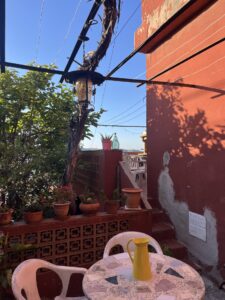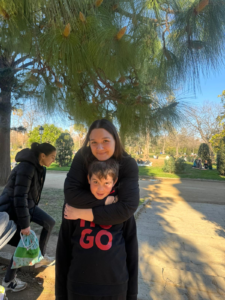Aside from teaching, a very important part of this programme is integrating into a new community and lifestyle. The highlight of the programme for me has been learning about Spanish culture from my host family and participating in local customs. Your cultural experience will be completely different whether you’re in a big city, or a tiny village, in the North, South, by the coast, or far inland. Regardless of where you are, there are lots of interesting things to do in Spain. As long as you make an effort to familiarise yourself with your local area and its customs, then you’ll get so much more out of your experience.
From Gastronomy and Festivals to Historical Sites and Amazing Routes: My Top 12 Things to Do in Spain

I live in Murcia, a medium-sized city, with a host family. Thus I’ve been lucky enough to experience many local customs through them and through stories from students. Whether you’re thinking of coming to Spain, or are already here for the year and stuck for things to see and do in Spain, then hopefully this article will spark your imagination. Here’s my list of favourite aspects of Spanish lifestyle and culture for those wondering what to do in Spain:

1) Learn about Olive Oil to Learn about Cultural Aspects of Spain
What is it about the world-renowned Mediterranean diet that doctors love? Olive oil. Everywhere you look in Spain, you can see olives: olive trees in fields and gardens, olives in little complimentary dishes in bars, and served alongside every meal. Spaniards don’t dare put any food into their mouth until they’ve drizzled olive oil all over it. If you eat your food without olive oil, prepare to be judged (just kidding).
Even though practically any olives you buy in a supermarket will taste nice, you should consider a more “authentic” olive experience. Actually, Spain is the largest producer of olive oil in the world, responsible for producing the 56% of the world’s total olive oil production.
When I went to a pueblo in Andalusia with my host family, they brought me to a local olive oil factory, which was fascinating. The surrounding hills have thousands of olive trees grown by local farmers and it was astonishing to see the process and get to try the finished product.
2) Pick Lemons to Experience Interesting Outdoors Activities in Spain
This is specific to Murcia, but each region will have particular fruits that they specialise in. In the South and in Valencia, typical fruits are oranges and lemons; and in the Basque Country in the North, you can find apples. A local tip: never pick fruit from trees in the city centre, as the nutrients in the fruit come from the soil of the tree and the trees in the city centre will be too polluted. Instead, people from the city drive to the surrounding countryside and pick fruit from orchards, which have fields and fields of lemon trees. The smell is spectacular! After you’ve picked the lemons, it’s up to you to decide what to do with them. The usual saying is that when life gives you lemons, make lemonade. However, in Murcia, if life gives you lemons then you slice them up and squeeze them over your paella!
3) Eat a Pig: One of the Most Typical Things to Do in Spain

Warning: it isn’t considered normal to be a vegetarian in Spain. In fact, the Spanish diet seems to be 50% pork (and 25% fish or seafood and then 25% olives and olive oil). The Spanish will eat pork for breakfast, lunch, and dinner. At Christmas time, it is very typical to buy a giant leg of jamón, which is dried ham. These can be very expensive and certain varieties are revered by Spanish foodies.
However, to be authentically Spanish, the best pork experience is sharing an entire suckling pig with friends. This dish is called Cochinillo asado. It’s not for the faint-hearted, but the Spanish people are far from faint-hearted. For meat-lovers, it’s an exquisite dish and I have to admit, it’s the most tender meat I’ve ever eaten in Spain. This dish is so legendary that many literary greats from Cervantes to Hemingway have written about it. Other Language Assistants have had interesting experiences with jamón indeed.
4) Participating in a Camino is the Best Thing to Do in Spain
Spain is a very Catholic nation, but also a nation that is very appreciative of its natural landscape. Combining these two characteristics, you can see why caminos are so popular! The most famous is the Camino de Santiago, which consists of different pilgrim routes that all lead to Santiago de Compostela in Galicia. Participants walk 20km a day and stay in hostels, collecting stamps along the way for their pilgrim passport. The camino is one of the most important things to do in Spain to explore the country and learn about its history.
For my very first weekend in Spain, my host family brought me along on a school trip to the Camino de la Cruz de Caravaca, in Murcia. This camino was relatively short and we only walked for a day, but it was a great way to see the local landscape and people for the first time. Everyone was in high spirts and cheering on ¡Buen Camino! to passing cyclists or other groups. I’m hoping to do some of the Santiago de Compostela in June once I finish teaching for the academic year, so watch this space.
5) Taking a Siesta, One of Those Fun Things to Do in Spain
I remember when I had my first Friday afternoon siesta, I woke up refreshed and invigorated and my host dad applauded me saying, “Now, you are really Spanish.” Before coming to Spain, I found it impossible to nap. Now, it’s a regular ritual for me and one of those things to do in Spain. I always feel more productive once I’ve had a siesta. It gives me energy for socialising in the evening time. While some Spanish people will religiously abide to the siesta ritual, research has shown that naps longer than 20 minutes can affect sleep patterns and digestion – so moderation is best! Despite this, I still happily nap.
My Irish friends are so confused by Spanish siesta times and the fact that shops are closed from 2 pm to 4/5 pm. “Don’t you find it annoying that they close and go home and sleep?” “No,” I reply, “Because I’ll be at home sleeping too.”

6) Tasting Wine and Visiting Wineries is Listed Among the Top Things to Do in Spain
Wine is essential to Spain, not only to its lifestyle but also to its industry. The regions that are most famous for their wine are Rioja and Navarra. When I arrived in Spain, they told me there are three different types of wine: white, pink and wine. A lot of Spanish people consider red to the best and only wine worth drinking so you can always rely on a glass of Rioja red. If you want a great day out, consider a visit to a winery. These wineries are all over Spain and typically involve a wine tasting and guided tour. My friend visited one of these bodegas in the Murcia region and the tour and tasting cost €6 in total! I’m still waiting for my opportunity to visit a winery but in the meantime, I’m enjoying glasses of wine with tapas.
7) Try Different Tapas
Wine goes hand in hand with tapas thanks to King Alfonso X. While there are different stories about its origins, the most popular is that King Alfonso X realised that workers were getting too drunk from drinking wine during their lunch break. To make the workers more productive, he brought in a law for establishments to serve a complementary portion of food with every drink. Unfortunately, tapas are no longer free with drinks (except in some regions like Madrid or cities in Andalusia, like Granada and Jaen). Granada is a tapas haven, and your faith lies entirely in the bar staff who decide which tapas you get with each drink! Even if you don’t make it to Granada, every region or city will have speciality tapas: my favourites are Ensaladilla rusa in Murcia and Patatas Bravas in Madrid. If you travel around Spain, ask for the local speciality tapa dish.

8) Historical Sites are One of Those Things to See in Spain
Spain is very popular for tourists, and this is thanks to its many UNESCO sites (50 in total). I have been here for five months and I have only seen three, which goes to show how vast the country is and how much there is on offer. Murcia surprisingly doesn’t have any UNESCO sites but there are local sites worth visiting. The most interesting aspect about history in Spain is that its historical sites vary from region to region.
In Murcia, the place of most historical importance is Cartagena, an important port of the Roman Empire. In the South, many important sites include those from the Moor times such as the Alhambra de Granada and the Mezquita de Cordoba. While in the cities, these will be more recent, including the Gaudí architecture in Barcelona. If you are wondering what to do for a weekend, take a look at the map and use this to plan your next trip.
9) The Importance of Watching a Flamenco Performance When Choosing Things to Do in Spain
Flamenco is one of Spain’s more popular traditions and while you can go watch it all over Spain, the best place to see it is in Seville. Attending Flamenco shows is one of the most popular activities in Spain for tourists. Flamenco has a long history that stems back to the Moors in Spain, although this is highly debated. In the South, the descendants of the Moors were cast aside as outcasts by Christians in Spain and so they set up cave communities. In these communities, the peasants would entertain each other through song and dance, a traveller from Northern Spain stumbled upon these caves in 1711 and the rest is history.
It is a very popular pastime for young girls, especially in Andalusia, and some dances vary depending on the region. My host family’s cousins, for instance, live in Sevilla and they take Flamenco classes and teach the dances to my host family. I still haven’t had the chance to go to a show, but I have friends who visited Sevilla and highly recommended it.
10) Attending a Futbol Match: Fun Activities in Spain
Football is not just a sport in Spain, it is a lifestyle. Everybody has a football team that they support and the rivalry between Real Madrid and FC Barcelona is in a league of its own. In my host family, the eight-year-old son plays football after school four times a week, twice with his league team and twice with a group from school. In the school, many people will have pencil cases, school bags or sports bags with the familiar football logos. When I first started teaching and students were getting to know me, every class would ask me which team I supported. This was a crucial question for them, they were ready to either accept me or judge me. Even as a newcomer in Spain, I knew that this would require a careful response. To be diplomatic, and humorous, I would always reply with “Ireland.”
11) Go to Festivals: It is One of the Best Things to See in Spain

Every region, city or pueblo will have its local festivals and traditions. The upcoming Semana Santa is an important week for many parts of Spain, including Murcia. Throughout Spain, there will be religious processions with different colour robes designated for each day.
The more exciting festival in Murcia however, will be the Bando de La Huerta; the spring festival. This is the week after Semana Santa, and my Bachillerato students described it as “a week-long party”. Each day, there is a different party and in the streets there are parades and barracas (fair stalls) where you can buy traditional Murcian food, such as sausage. The most outlandish day is called Entierro de la Sardina (The Burial of the Sardine), which is a giant parade that culminates in the burning of a giant sardine sculpture. I can’t wait to experience it. This event was honoured in 2012 with the title of Fiesta of International Tourist Interest, only held by other 30 festivities in Spain.
12) Participate in a Capea

While outsiders to Spain embrace its gastronomic culture of tapas and wine, one aspect of Spanish culture that outsiders tend to shy away from is bullfighting. Even amongst Spanish people, bullfighting is a divisive topic. However, to many it is a part of their nation’s identity. Some tourists could list bullfighting among the things to do in Spain.
I haven’t gone (or plan on going) to watch bullfighting, but last weekend my host family took me to a child-friendly version, known as capea. Some people consider it nonviolent and describe it as “Play fighting”. Anybody can play with a young calf within a small ring and try and get it to chase them and their red sash. It is a family weekend activity that includes traditionally cooked food outdoors, like a big pan of chicken and rice. It is not that violent, and an interesting insight into Spain’s relationship with bullfighting. After seeing a capea, I thought, “Now, I understand Spain a bit better.”












28 Responses
I love your suggestions! While I have tried most of them I still need to go to a winery and participate in a Camino. I’ve learned when it comes to Spanish food one of the most fun things to do is order something without reading the description. I once went to a restaurant with a friend and we ordered all 15 tapas (they were 1 euro each) and we had a blast trying different things outside my comfort zone. There are so many things to do in Spain to have fun, it’s all about finding things that best suit your interests. I have joined a hiking club in the city I live in and I’m having a blast exploring different places and getting out of the city on the weekends. You’ll never know if you like something until you try it!
This was certainly a fun article to read, and made me realise how lucky I am to have experienced a lot of them! I can’t wait to keep adding more and more interesting and awesome things to my own list while in this amazing diverse country!
This is brilliant!! The list of things to do/try in Spain is literally endless – I’ve done a few of the things on the list but definitely will be adding some more things to do before I go!
These tips are great! I’ve checked some of these suggestions such as eating Marinera and Cochinillo, attending a flamenco performance, and participating in Spanish siestas. But there is still so much to do! I live in Murcia now and I’m so excited for Bando de la Huerta which will be in two months! And I can’t wait for more adventures here in Spain.
I’m hoping to top my year off with a full Camino experience doing the French Way for a whole month!! I’ve read a ton about it and definitely need to start physically preparing because 20km a day is not something that I’m used to. I’ve loved learning about it from my students, too. They have a tradition here at my school that they take the 3 ESO kids every year for a four day Camino trip. They celebrate mass every day and enjoy each other’s company, something I find quite relaxing about Spanish culture.
Yes to the food, tapas, olive oil, and especially the siestas! I’ve gotten so used to have a few hours of relaxing and sleep midday, it’s going to be hard to get out of this habit! Spain is such a cool place, I’ve loved hearing about your experience and events local to your time in Murcia!
love the football games! I got to see one in Barcelona and it was incredible because of the football pride here (and everywhere in europe), but seeing such famous players was so cool!
Thank you so much for sharing! I’m living in Cartagena for the 2018-2019 academic year, so I was really excited to read the experiences of someone who lived in the same region! I’m definitely looking forward to all the wine, lemons, and the Bando de la Huerta 🙂
Hi Cassie, glad you enjoyed the article! Cartagena is gorgeous and it’s right by the sea so it’ll be a great place to spend the year. If you have any questions about Murcia then feel free to get in touch. I’m sure you’ll have a great time, especially at Bando de La Huerta!
Wow this is a great article, so many fun things I haven’t tried yet!! I’ve never heard of capea before, but it sounds like a great way to learn about the bullfighting traditions in a less controversial way. And I totally agree about the olive oil, I did not realise how popular and sacred it is here!
Hi Rebecca, glad you enjoyed the article! I’d never heard of capea either but that just goes to show how much about Spain we have yet to learn and how much there is here to discover. Haha, Spain has opened my eyes to the wonders and versatility of olive oil!
Great ideas and advice! Funny about the olive oil but so true, I was actually eating salad at school the other day and I didn’t put any olive oil on it and the teachers literally stared at me with shocked looks on their faces and said I was weird! About the siestas in Spain, I actually learned recently that a lot of Spanish people don’t have siestas anymore and that more people in America have “siestas” (naps). I’m also living in Rioja and people up here say “vino or white?” because they don’t consider white to be real “wine” haha. And I actually saw a Flemenco show last weekend and while I liked it, I wasn’t overly impressed and was sometimes bored. My friend told me that in Seville it is much better!
Hi Paige, glad you enjoyed the article. Wow, that’s really interesting about the American trend. I love how they refer to wine as wine only when it’s red. Living in Rioja, you must be able to experience some amazing wine! Have you visited any wineries? I am planning on visiting Seville next month so I may go watch a Flamenco show there and it seems like the most appropriate and authentic place to do so!
Wow, this is such a great list of the “top things” in Spain! I really enjoyed reading this and was trying to make sure I had done everything on the list, since this is my third year now. The only things I’m missing is the olive oil experience and the Camino. The Camino is something I’ve been meaning to do since I got her so I really need to get on that! Love all of the things about food and drinks because that is my favorite part of Spain! Thanks for the post!
Hi Natalie, glad you enjoyed the article! Your third year, wow! You must have explored and experienced so much, what has been your favourite Spanish experience? I am very excited to do the Camino de Santiago, I think that’ll be my favourite experience.
I love how thorough this list is! I’ve never been to Murcia, but now you’re making me want to visit. I’d also never heard of capea before, so it was interesting to learn about this option.
Hi Elizabeth, glad you enjoyed the article! Haha, my students will love that. Murcia isn’t very touristy, so it’s a very authentic “Spanish” destination. I had never heard of capea either, living with a host family has taught me so much about Spanish culture.
These are such fun ideas! I can definitely recommend going around to wineries! There’s so many throughout Spain and it’s a great way to experience some of the smaller villages as well.
Hi Christa, glad you enjoyed the article! I still haven’t been to a winery yet, but I’m excited to go.
Yes! I imagine you’ll enjoy the wineries here!
After seeing your list of things to do I feel likening haven’t done anything! You’ve experienced so much in your time here and that’s incredible. I need to start picking lemons I guess.
Hi Mariah, glad you enjoyed the article. Don’t fret, you have two months left so plenty of time to make your way through this list and find some lemons!
What team do you support in Ireland though? Jajajaja
I’ve found it pretty easy to be a vegetarian in Spain. The sheer volume of fresh fruit and vegetables available on almost every street makes it super possible.
Haha, not saying!! Yeah, Spain has an amazing selection of fruits and vegetables so I definitely agree that if you’re living independently, being a vegetarian is easy. However, with a host family, especially one that is traditionally Spanish, it might be difficult!
Thanks for your tips Orla! I have to say I’ve been in Spain nearly two years and I haven’t thought to go and pick lemons! I’d love to try that, it sounds really fun. What I particularly love about Spain is that every region, every city, every town, every tiny village has its own festivals and activities, and youre experience can vary greatly depending on where you are! This means there’s always something new to discover, no matter how long you’ve lived here.
Lemon picking is really fun. In fact I don’t think many people here buy lemons in shops because they can go to the countryside and pick them!! I’m glad that you enjoyed the article, and that’s very true – the local festivals are essential to the Spanish experience.